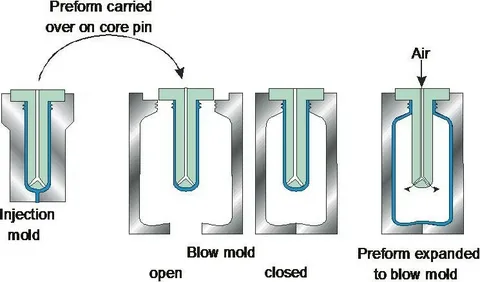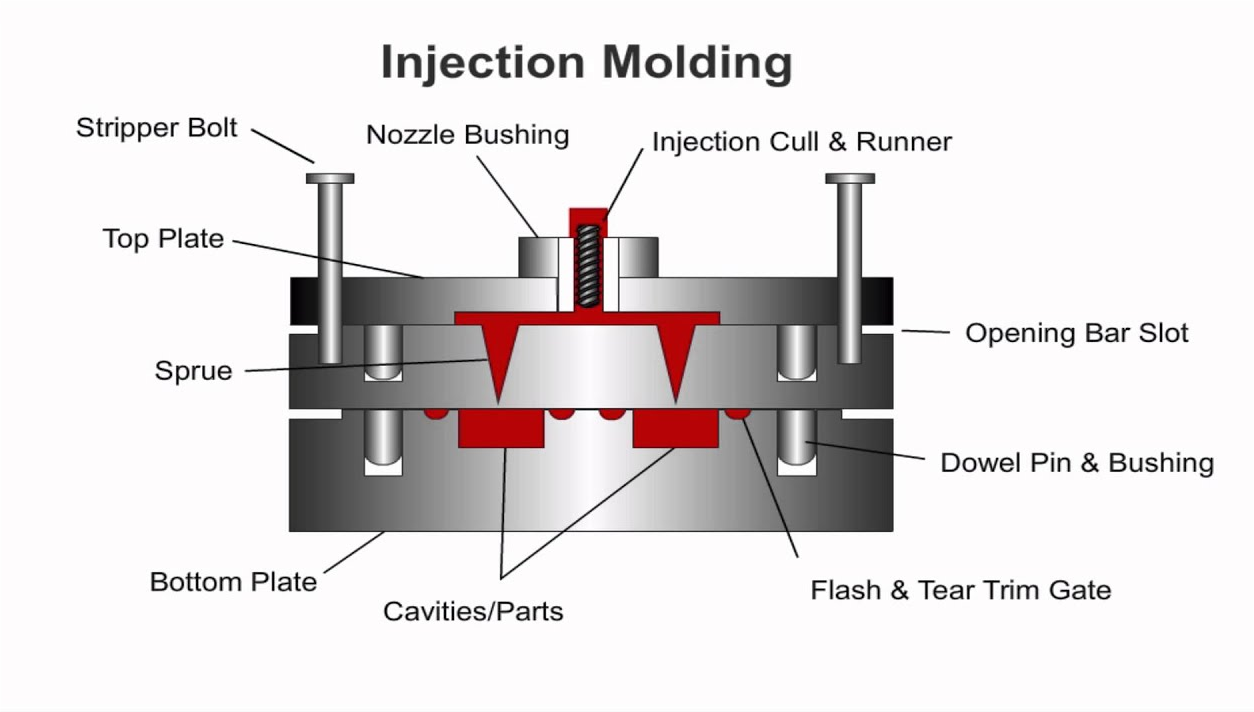The difference between blow molding and injection molding
What is Blow Molding?
Blow molding is a plastic molding process similar to glass blowing. In this process, plastic raw materials are first heated to a certain temperature (depending on the type of plastic). Subsequently, an extruder squeezes out the heated plastic material, forming a hollow tube, also known as a parison.
Operators place the parison into a prepared mold and blow air into the mold (at a pressure of about 80 psi). As a result, the parison expands within the mold, taking on its shape. After cooling, the plastic solidifies according to the mold design, forming a hollow part. Subsequent trimming takes place.

Types of Blow Molding
There are three types of blow molding:
-
1. Injection Blow Molding
This involves injecting the parison, made of a plastic rod or core rod, into the mold cavity. As a result, the parison takes on a test tube shape. After insertion into the mold, air is blown into the parison to form the shape of the mold. -
2. Extrusion Blow Molding
There are two variations: continuous or intermittent. In the continuous variant, the parison is continuously fed into the mold and cut with a blade during cooling. On the other hand, the intermittent variant expels the molded part before inserting a new parison. Therefore, the intermittent variant is more cost-effective and takes less time. -
3. Injection Stretch Blow Molding
This combines injection molding and blow molding processes to manufacture plastic parts. The process begins by using injection molding to produce a solid preform. Subsequently, the machine heats the preform and blows air into it. -
Medical Injection Molding Services
Our medical injection molding services leverage advanced injection molding technology to produce high-precision, reliable, and sterile components essential for the healthcare industry. We specialize in manufacturing a variety of medical parts, such as syringes, implantable devices, and diagnostic equipment, adhering to strict industry standards and regulatory requirements. Our facilities utilize cleanroom environments to ensure the highest levels of hygiene and quality control, making us a trusted partner for medical device manufacturers seeking consistent and high-quality injection-molded products.
The blow molding process has the following advantages:
- 1. Lower production costs compared to injection molding.
- 2. Lower initial machine investment.
- 3. Eliminates the need for two-part mold components.
- 4. Offers significant flexibility in part design.
What is injection molding?
Injection molding involves the use of precision molds and tools to manufacture solid plastic parts. The molds are components with the final product design, made of materials such as steel and aluminum, utilizing high-precision processes and tolerances like CNC machining.
After designing and manufacturing the molds, the injection process begins. The first stage involves melting the injection molding material at a very high temperature (depending on the plastic polymer). Additionally, operators inject the molten plastic into the mold under high pressure. Following injection, cooling takes place to harden the plastic polymer, followed by ejection. Surface finishing can also be applied to the parts.

Advantages of injection molding include:
- 1.Development of highly detailed molds with multiple cavity options.
- 2. High precision in production.
- 3. Cost-effectiveness for large-volume production.
- 4. Excellent material flexibility, color choices, and efficiency.
Are you looking for a company that provides injection molding services, ensuring high-quality plastic molded parts at competitive prices within a short timeframe? Well, you’ve found what you’re looking for. XY-Global is a professional company specializing in the production of related products, offering manufacturing services, including injection molding. Our robust injection molding capabilities can assist in producing high-quality injection molds and plastic molded parts.
Understanding the differences between blow molding and injection molding is crucial for selecting the right manufacturing process for your specific needs. While blow molding excels in producing large, hollow containers, injection molding is the preferred choice for creating detailed and high-precision components, especially in the medical field where precision and hygiene are paramount.

